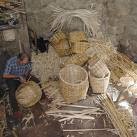Wicker, Basketry and Empreita (Palm Handmade Craft)
Braids of cane and palm
Two craft activities more representative of the Algarve are the contract and a thin braided palm wrapped in various sizes, and basketry, resulting from the technique of weaving cane and wicker, with such great perfection that makes the baskets Algarve's most famous South Portuguese. Examples of traditional techniques that are distinguished by the material, utility, creative variations and also the specific nature of the labor force, since the contract has traditionally been a women's work and maneuver the cane is carried out almost exclusively by men.
The regional focus of each of these activities depends on the proximity of raw material, but both remain all over the Algarve, but one of the best places to see it real time is in Querença, situated 10Km North of the city of Loulé.
The contracts, so called because once have been paid according to the amount produced per day, is characteristic of the area of the hinterland, where the palm, a species of dwarf palm grows in the woods. Loulé is the county par excellence of craftsmanship, which consists of weaving palm leaves and are then sewn with skill and ability in the form of mats, rugs, shaking, tions, baskets and hats. Tools that they still have the importance of old, but adapted by the imagination of artisans to the taste and need of our times.
The baskets are also an activity that thrives in the municipality of Loulé, and even today, in a typical village Querença is easily artisans who make handmade utilitarian objects such as baskets for the eggs, mats for drying fruit or pots to fish. Also in the coastal areas, most brainstem Serra de Monchique and the Guadiana Valley, where the cane grows freely, it is still possible to find some objects of basketry.
In this technique, the weaving of cane and wicker to make a wide variety of baskets,
gaining specific features depending on the region. The wicker baskets of the people of Monchique are the original shape and color. In the case of Vila Real de Santo António, cane basket is round and with a lid. In Odeleite, baskets made of wicker or cane, has a very utilitarian nature, serving to save the fruit and the river fishing.
Other parts are common on the Algarve the basket hard and red, with four legs and two wings, great for carrying chickens or brittle objects, and the lintels originating Querença, Loulé, made from vines and canes.












































































This blog is cool!
ResponderEliminarI Digg thhis!